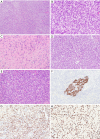Spindle cell thymoma and its histological mimickers
- PMID: 37701646
- PMCID: PMC10493621
- DOI: 10.21037/med-22-50
Spindle cell thymoma and its histological mimickers
Abstract
Spindle cell thymomas are the most common spindle cell neoplasms of the anterior mediastinum. These tumors belong to the group of thymic epithelial neoplasms and are known for their wide histomorphologic spectrum. This histological heterogeneity is the reason why unequivocal diagnosis can be challenging, especially when dealing with small biopsy material. Conversely, less conventional patterns of the tumor may also pose significant diagnostic problems in resected material and the differential diagnosis often includes other spindle cell neoplasms that are known to arise in the mediastinal cavity. These can be of variable origin and may share overlapping pathological features with spindle cell thymoma. Since spindle cell thymomas are tumors that primarily affect the adult population and predominantly arise from the thymic gland in the anterior mediastinum, this review will focus on the differential diagnosis with other spindle cell neoplasms that share similar demographic characteristics and, for the most part, originate from the anterior mediastinal compartment. These include other epithelial spindle cell tumors of thymic origin (sarcomatoid thymic carcinoma and spindle cell carcinoid tumor), mesenchymal neoplasms [solitary fibrous tumor (SFT), synovial sarcoma, and dedifferentiated liposarcoma] and various other tumors with spindle cell morphology, that may occasionally involve the anterior mediastinum. The clinical, pathological, immunohistochemical and molecular hallmarks of these lesions will be discussed and useful tips for the differential diagnosis with spindle cell thymoma will be provided.
Keywords: Mediastinum; sarcoma; spindle cell; thymic carcinoid tumor; thymic carcinoma; thymoma.
2023 Mediastinum. All rights reserved.
Conflict of interest statement
Conflicts of Interest: The author has completed the ICMJE uniform disclosure form (available at https://med.amegroups.com/article/view/10.21037/med-22-50/coif). AW serves as an unpaid editorial board member of Mediastinum from October 2021 to September 2023. The author has no other conflicts of interest to declare.
Figures










Similar articles
-
Spindle-cell lesions of the mediastinum: diagnosis by fine-needle aspiration biopsy.Diagn Cytopathol. 1997 Sep;17(3):167-76. doi: 10.1002/(sici)1097-0339(199709)17:3<167::aid-dc1>3.0.co;2-c. Diagn Cytopathol. 1997. PMID: 9285187
-
Pigmented spindle cell carcinoid tumour of the thymus with ectopic adrenocorticotropic hormone secretion: report of a rare variant and differential diagnosis of mediastinal spindle cell neoplasms.Histopathology. 2002 Feb;40(2):159-65. doi: 10.1046/j.1365-2559.2002.01339.x. Histopathology. 2002. PMID: 11952860
-
Spindle cell tumors of the mediastinum.Ann Diagn Pathol. 2022 Oct;60:152018. doi: 10.1016/j.anndiagpath.2022.152018. Epub 2022 Jul 22. Ann Diagn Pathol. 2022. PMID: 35908333 Review.
-
The histomorphologic spectrum of spindle cell thymoma.Hum Pathol. 2014 Mar;45(3):437-45. doi: 10.1016/j.humpath.2012.08.025. Epub 2012 Dec 20. Hum Pathol. 2014. PMID: 23260329 Review.
-
Thymic carcinoma arising in thymoma is associated with alterations in immunohistochemical profile.Am J Surg Pathol. 1998 Dec;22(12):1474-81. doi: 10.1097/00000478-199812000-00004. Am J Surg Pathol. 1998. PMID: 9850173
References
-
- Weissferdt A. Mesenchymal Tumors of the Mediastinum. In: Weissferdt A. Diagnostic Thoracic Pathology. 1st ed. Cham: Springer; 2020:972.
-
- Ströbel P, Badve S, Chan JKC, et al. Type A thymoma. In: World Health Organization. WHO Classification of Tumours Editorial Board. Thoracic Tumours. 5th ed. Lyon: IARC Press; 2021:326-31.
Publication types
LinkOut - more resources
Full Text Sources
